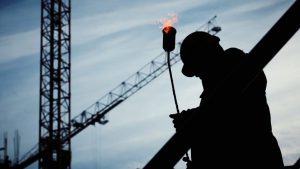The summer heat of 2023 may be behind us in Canada, but it’s very likely there will be a repeat of extreme temperatures in the future.
Extreme heat takes a toll on construction workers’ safety and productivity. Although Canada sits in a moderate climatic zone, daytime heat during the summer months will be a workplace safety issue that our construction industry cannot ignore.
In a 2022 interview published by the University of Texas School of Public Health, Bethany Alcauter, PhD, spoke about the need for strict enforcement of safe practices for outdoor working populations.
“What was most startling to me was that so many of the workers were experiencing several very concerning issues on a daily basis. Seventy-five per cent reported at least one or more symptoms of a heat-related illness during one of the two days of data collection, 100 per cent had at least one urine measurement that indicated severe dehydration, 44 per cent tested positive for blood in their urine, and 12 per cent (n = 2) may have experienced rhabdomyolysis during data collection.”
Washington, D.C.-based consumer rights advocacy group, Public Citizen, estimates extreme heat is one of the three main causes of death and injury in the American workplace, contributing to between 600 and 2,000 deaths a year, along with 170,000 injuries.

Worker productivity also takes a big hit during high heat. Extreme temperatures leave heavy road pavers and infrastructure workers particularly vulnerable, adding to a drop in productivity that has been declining in that sector for several years. There are also concerns about non-union contractors who may not be following recommended guidelines.
Amir Jina of the University of Chicago believes once temperatures reach 32 C, focus and work capacity begins to decline quickly.
“Above that, we just start to see the hours that people work being eaten away,” he said.
Drawing on an analysis of their dataset of 750,000 past programs from around the world, U.K. software company nPlan examined the impact of extreme heat on physical work.
“According to our data science team, construction activities involving physical work take, on average, 36 per cent longer to execute during extreme heat.”
Construction companies in climatic zones already experiencing unprecedented heat waves are taking steps to deal with the safety and productivity impacts. Some are adjusting shifts and schedules away from the midday temperature peaks, and building longer breaks into each work shift. Certain work is simply postponed during days of continual extreme heat.
While many jurisdictions are considering putting new safeguards into place to protect workers vulnerable to high heat, Texas recently attempted to do just the opposite.
This summer, in the middle of a sweltering heat wave that spanned the state, Gov. Greg Abbott signed a bill into law that would, among other things, override existing city ordinances mandating rest and water breaks for construction workers, beginning in September. Nicknamed the “Death Star Bill,” the law resulted in significant backlash from unions and sparked legal challenges. On Aug. 30, a state district judge struck down the legislation as unconstitutional.
Such moves restricting worker breaks during periods of high heat are very unusual. Although the U.S. lacks an enforceable national standard for extreme heat protection, some states have, or are developing, guidelines that exceed even OSHA maximum heat standards.
The regulatory situation is currently the same in Canada, with only Ontario specifying maximum allowable heat conditions for indoor and outdoor construction work.
In fact, new Ontario legislation has been proposed to better protect workers, given the increased future likelihood of extreme heat during the busy construction season. The overall guidelines being established by the Ministry of Labour are designed to prevent core body temperatures rising above 38 C.
If passed, employers would be required to take steps to assess the risk of exposure to heat stress and implement a number of measures to limit extreme heat exposure and, in some cases such as indoor work, put “engineered controls” in place to protect their workers.
John Bleasby is a Coldwater, Ont.-based freelance writer. Send comments and Climate and Construction column ideas to editor@dailycommercialnews.com.










Recent Comments
comments for this post are closed